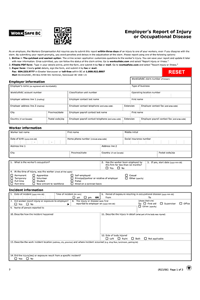How employers report a workplace injury or disease
If a person working for you has a work-related injury or disease and gets medical treatment from a doctor or other qualified practitioner, as the employer you must report the incident to us. We need to hear from you as soon as possible. Using our online tool is usually the fastest way to make your report.
Filing online also allows you to update reports if you receive additional information later on. You can file online whether or not you have an online services account. You can create an online services account at any time.
If we have already received a report of injury from the worker, you will notice that some fields on the online form contain information the worker provided.
How to report an injury
| With an account (recommended) |
Log on or create an account |
| Without an account |
If you’ve received a Form 7 request notice, you can submit your report without an online account. |
| Form (fax or mail) |
|
As the employer, you must immediately report serious incidents and fatalities to us by calling the Prevention Information Line. This is in addition to reporting an injury related to a claim.
You must immediately report serious incidents and fatalities. Employers are also required to report any workplace injury or disease within three days of the incident, if the worker missed time from work or required medical attention beyond first aid in the workplace.
You can submit a report even if you don't have all the details of the incident yet.
Not reporting an injury is an offence under the Workers Compensation Act and can result in fines. Coercing a worker not to report an injury is also an offence.
To fill out your report to us, you should have the following information:
- Suggestions for transitional work and/or a modified work schedule to support the worker's safe return to work.
- Contact information for your company and the worker
- Details of the incident(s) that led to the injury or disease.
- The days (or shifts) missed due to the injury, if any.
- The worker's work schedule and rate of pay. If the worker has missed time from work due to the injury, we'll also need to know the worker's total earnings over the last 12 weeks.
If you disagree with a claim being filed for a worker's injury or illness, you can let us know by filling out the "Objection" box on your report of injury. If you need to supply additional details, you can call, fax, or mail us a letter explaining your reasons for objecting to the claim.
We assign a claim number when we receive a report of injury. We share this number with the worker, their employer, and their health care provider. Please use this number when communicating with us about the claim.
Workers should also give the claim number to anyone who provides medical treatment related to the claim.
You may need to send us information about the worker's earnings. This is needed if the worker misses time from work, other than on the day of the injury. Including the right amounts will ensure that the worker's compensation benefits are calculated correctly.
What to include in earnings information:
- The worker's regular earnings, including any overtime earnings
- The worker's earnings during illness, such as sick bank or any other pay.
- The worker's vacation pay if:
- The worker loses entitlement to vacation pay while disabled
- You pay it out on regular paycheques rather than keeping it for the worker to take as time off with pay
- Vacation pay was earned before the injury and is, or will be, paid out.
What should not be included in earnings information:
- Long-term disability (LTD) benefits that you or an LTD insurer paid to the worker
- WorkSafeBC benefits already paid to the worker
- Special expenses such as car or tool allowances
- Amounts that represent a reimbursement or per diem allowance for travel or meal expenses
- Your portion of payroll deductions, including deductions for CPP, EI, benefit plans, etc.
- Amounts that represent payment to the worker for rental of equipment
If the worker is not able to work, it’s important for you to stay in touch with him or her. Whenever possible offer alternate work or a modified work schedule to support his or her recovery at work.

